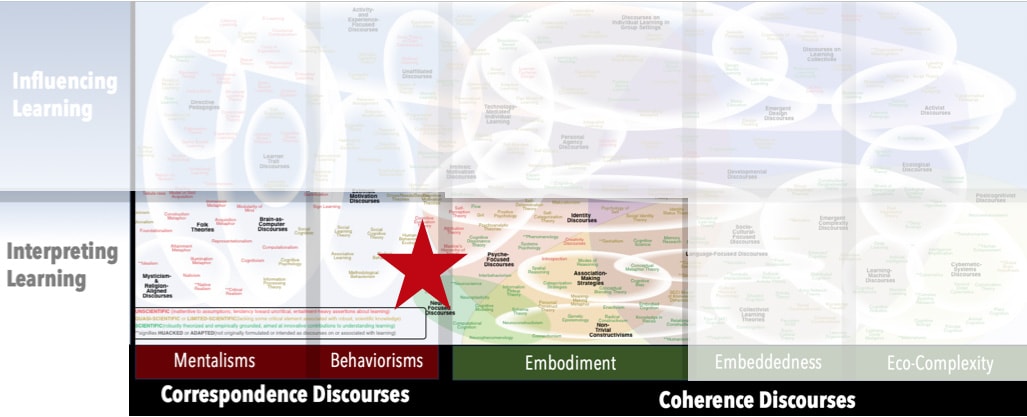AKA
Purposive Behaviorisms
Sign Theory
Sign-Gestalt Theory
Correspondence Discourses are perspectives on learning that assume a radical separation of mental (or internal, or brain-based) and physical (or external, or body-based). That separation sets up the need for a correspondence between what’s happening in the real, objective world and what’s happening in one’s inner, subjective world. Most assume object-based metaphors, linear/direct imagery, and Newtonian mechanics, thus framing learning in terms of acquiring, attaining, inputting, and/or linking.
Learn More...Coherence Discourses regard distinctions and descriptions as useful devices to make sense of the complex dynamics of learning, but they caution that such devices are mere heuristic conveniences. Coherence Discourses suggest that truths do not exist independently or outside of a system – which is a commentary on humans’ understanding of reality, not a commentary on reality. Most Coherence Discourses employ biological and ecological metaphors, with dynamics framed in evolutionary terms.
Learn More...“Learning as acquisition” – the Acquisition Metaphor – is probably the most commonly invoked learning metaphor in English. It is evident in such phrases as “grasping the point,” “taking things in,” “getting it,” “picking things up,” “hard to swallow,” “remember this stuff,” and “cramming for the test.” It is not theoretically sophisticated, relying on the assumption that knowledge comprises externalized objects, and asserting that learning is a process of moving those objects from the outside to the inside.
Learn More...Folk Theories exist within every realm of human engagement. They are, in effect, uncritical and often-indefensible principles of action and interpretation that are woven through everyday language and broad cultural sensibilities. In effect, most of the past 150 years of research into learning has been focused on exposing Folk Theories and exploring more conscious and scientifically robust alternatives.
Learn More...Behaviorisms reject the notion that knowledge is some sort of external, stable, and context-free form. Rejecting attempts to explain learning in terms of unobservable mental processes, Behaviorisms focus instead on observable and measurable phenomena – thus operationally defining learning in terms of changes in behavior that are attributable to environmental factors.
Learn More...Cognitivism is explicitly developed around the metaphor “brain as computer.” It thus focuses on how information is acquired, processed, and organized. Learning is seen in terms of integration of new information into existing structures through processes of internal codification.
Learn More...In Gestaltism, an individual’s mind is seen as a global whole that generates its own reality. Gestaltism embraced notions of self-organization and emergence in descriptions of the mind as arising in the interactions of but transcending its parts. Gestaltism thus rejected Behaviorisms and other theories that rely on Newtonian mechanics to describe and/or explain cognition.
Learn More...Focus
Combining Behaviorisms, Cognitivism, and Gestaltism into a single theory of learning.
Principal Metaphors
Sign Learning is a mash-up of Behaviorisms, Cognitivism, and Gestaltism. It thus lacks a focused web of associations, and often falls back on Folk Theories – especially the Acquisition Metaphor:
- Knowledge is … scope of possible actions and interpretations
- Knowing is … acting framed by coherent mental weave
- Learner is … an information-processing organism
- Learning is … acquisition of knowledge through meaningful behavior
- Teaching is … training; engineering behavior
Originated
1950s
Synopsis
Sign Learning was an attempt to bridge Behaviorisms, Cognitivism, and Gestaltism. The theory begins by rejecting the cause–effect dynamics assumed by most Behaviorisms, arguing instead that stimulus–response pairings are actually processed and selected in the mind’s control room to generate a more holistic internal map of the environment. That is, Sign Learning studies learning on the level of purposeful, goal-directed behaviors, rather than on the level of singular responses to singular stimuli. Relevant subdiscourses include:
- Response Learning (Movement Learning) – contrasted with Place Learning (see below), learning a sequence of actions to accomplish a desired task
- Place Learning – contrasted with Response Learning (see below), creating a cognitive map that enables one to accomplish a desired task
Commentary
Sign Learning was subjected to criticisms levelled against all of its source domains. From Behaviorisms, it was accused of lacking evidence and explanations for cognitive processes. From Cognitivism, it was accused of being beholden to observation-based research methods that limited its range of analysis. And from Gestaltism, it was seen as seeking to hijack insights of emerging Coherence Discourses, even while maintaining incompatible assumptions of Correspondence Discourses (apparently without awareness).
Authors and/or Prominent Influences
Edward Tolman
Status as a Theory of Learning
Sign Learning is a theory of learning – or, perhaps more appropriately, a mashup of theories of learning.
Status as a Theory of Teaching
Sign Learning is not a theory of teaching.
Status as a Scientific Theory
Sign Learning falls short on all our criteria of scientific theories. Its attempt at a mash-up of different, incompatible perspectives indicates the opposite of critical attentiveness of underlying metaphors and other commitments. As well, its empirical evidence was drawn strictly from experiments on rats.
Subdiscourses:
-
Place Learning
-
Response Learning (Movement Learning)
Map Location

Please cite this article as:
Davis, B., & Francis, K. (2022). “Sign Learning” in Discourses on Learning in Education. https://learningdiscourses.com.
⇦ Back to Map
⇦ Back to List

